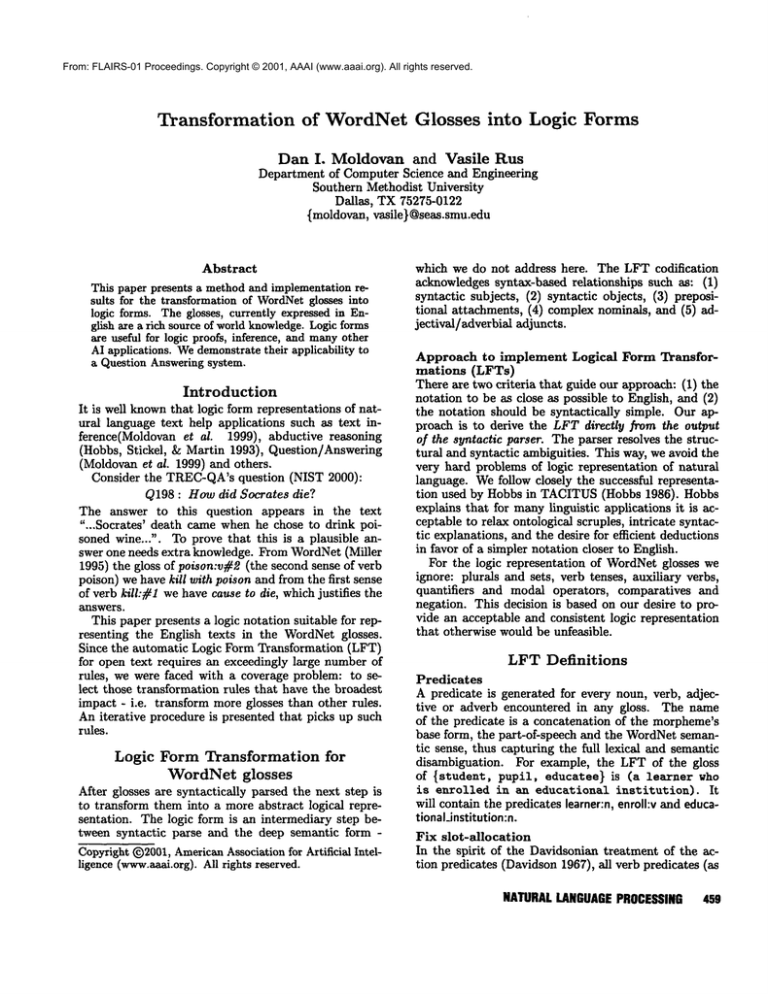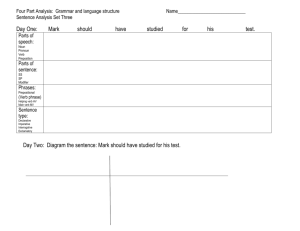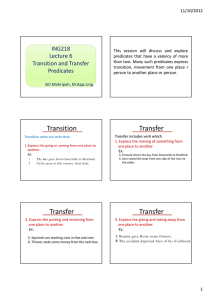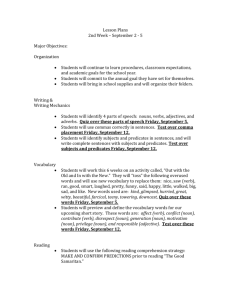
From: FLAIRS-01 Proceedings. Copyright © 2001, AAAI (www.aaai.org). All rights reserved.
Transformation of WordNet Glosses into Logic Forms
Dan I. Moldovan and Vasile Rus
Department
of ComputerScienceand Engineering
Southern
Methodist
University
Dallas,TX 75275-0122
{moldovan, vasile}@seas.smu.edu
Abstract
This paper presents a methodand implementation resuits for the transformation of WordNetglosses into
logic forms. The glosses, currently expressed in English are a rich source of world knowledge.Logic forms
are useful for logic proofs, inference, and manyother
AI applications. Wedemonstratetheir applicability to
a Question Answeringsystem.
Introduction
It is well knownthat logic form representations of natural language text help applications such as text inference(Moldovan et al. 1999), abductive reasoning
(Hobbs, Stickel, & Martin 1993), Question/Answering
(Moldovan et al. 1999) and others.
Consider the TREC-QA’squestion (NIST 2000):
Q198 : Howdid Socrates die?
The answer to this question appears in the text
"...Socrates’
death came when he chose to drink poisoned wine...". To prove that this is a plausible answer one needs extra knowledge. From WordNet(Miller
1995) the gloss of poison:v#2 (the second sense of verb
poison) we have kill with poison and from the first sense
of verb kill:#1 we have cause to die, which justifies the
answers.
This paper presents a logic notation suitable for representing the English texts in the WordNet glosses.
Since the automatic Logic Form Transformation (LFT)
for open text requires an exceedingly large number of
rules, we were faced with a coverage problem: to select those transformation rules that have the broadest
impact - i.e. transform more glosses than other rules.
An iterative procedure is presented that picks up such
rules.
Logic Form Transformation
WordNet glosses
for
After glosses are syntactically parsed the next step is
to transform them into a more abstract logical representation. The logic form is an intermediary step between syntactic parse and the deep semantic form Copyright~)2001, AmericanAssociation for Artificial Intelligence (www.aaai.org).All rights reserved.
which we do not address here. The LFT codification
acknowledges syntax-based relationships such as: (1)
syntactic subjects, (2) syntactic objects, (3) prepositional attachments, (4) complex nominals, and (5)
jectival/adverbial adjuncts.
Approach to implement Logical Form Transformations (LFTs)
There are two criteria that guide our approach: (1) the
notation to be as close as possible to English, and (2)
the notation should be syntactically simple. Our approach is to derive the LFT directly from the output
of the syntactic parser. The parser resolves the structural and syntactic ambiguities. This way, we avoid the
very hard problems of logic representation of natural
language. Wefollow closely the successful representation used by Hobbs in TACITUS(Hobbs 1986). Hobbs
explains that for manylinguistic applications it is acceptable to relax ontological scruples, intricate syntactic explanations, and the desire for efficient deductions
in favor of a simpler notation closer to English.
For the logic representation of WordNetglosses we
ignore: plurals and sets, verb tenses, auxiliary verbs,
quantifiers
and modal operators, comparatives and
negation. This decision is based on our desire to provide an acceptable and consistent logic representation
that otherwise would be unfeasible.
LFT Definitions
Predicates
A predicate is generated for every noun, verb, adjective or adverb encountered in any gloss. The name
of the predicate is a concatenation of the morpheme’s
base form, the part-of-speech and the WordNetsemantic sense, thus capturing the full lexical and semantic
disambiguation. For example, the LFT of the gloss
of {student,pupil,educatee}is (a learnerwho
is enrolledin an educationalinstitution).It
willcontain
thepredicates
learner:n, enroll:v andeducational_institution:n.
Fix slot-allocation
In the spirit of the Davidsonian treatment of the action predicates (Davidson 1967), all verb predicates (as
NATURAL
LANGUAGE
PROCESSING 459
well as the nominalizations representing actions, events
or states) have three arguments: action/state/eventpredicate(e,xl,X2), where:
¯ e represents the e~entuality of the action, state or
event i stated by the verb to take place,
¯ zl represents the syntactic subject of the action, event
¯ or state, and
¯ x2 represents the syntactic direct object of the action,
event or state.
For example, the LFT of (a person who backs a
politician),
the gloss of {supporter, protagonist,
champion, admirer, booster,
friend}
is: [person:n(zl)& back:v(el,Zl,X2) & politician:n(x2)
]. Severalclarifications are in order here.
(a) In case when the predicateis a ditransitive
verb,itsrepresentation
is verb(e,:rl,Z2,xs).
Forexample: professor gives students the grades is
represented as: professor(z1) & give(el,zl,z~,~3)
grade(x2) & student(xs). This condition is detected
the presence of two noun phrases following a verb in
active voice.
(b) The arguments of verb predicates are always in the
order: subject, direct object, indirect object. In the
case when one of these syntactic roles is missing, its
respective argument appears under the verb predicate,
but that argument will not be used by any other predicate. This is a so-called "slot-allocation" representation
since the position of the arguments is fixed for the purpose of a simpler notation. Since in WordNetglosses
not manyverbs have indirect objects, the argument x3
is used only when necessary, otherwise is omited. However, the arguments for the subjects and direct objects
are always present, even when the verb does not have
these syntactic roles. Wefound that this simple and
consistent representation is easy to derive and use.
Modifiers
The role of complements within a phrase is replicated
in the LFTs. Predicates generated from modifiers
share the same arguments with the predicates corresponding to the phrase heads. Adjective predicates
share the same argument as the predicate corresponding to the noun they modify. An exemplification is
the LFT of the gloss of {artifact,
artifact},
which
maps (a man-madeobject) into [ object:n(:~l)
manmade:a(xl)]. Similarly, the argument of adverbial predicate is the argument marking the eventuality of the
event/state/action they modify. For example, the gloss
of the verb synset {hare} is (run quickly), producing
the LFT= [run(ez,xl,x2) & quickly(e1)].
Conjunctions
Conjunctions are transformed in predicates, which enable the aggregation of several predicates under the
same syntactic role (e.g. subject, object or prepositional object). By convention, conjunction-predicates
have a variable number of arguments, since they cover
a variable number of predicates. The first argument
represents the "result" of the logical operation induced
by the conjunction (e.g. a logical and in the case of the
46O
FLAIRS-2001
and conjunction, or a logical or in the case of the or
conjunction). The rest of the arguments indicate the
predicates covered by the conjunction, as they are arguments of those predicates as well. Table 1 provides
examples of conjunction predicates.
Prepositions
Wealso generate predicates for every preposition encountered in the gloss. The preposition predicates always have two arguments: the first argument corresponding to the predicate of the head of the phrase
to which prepositional phrase is attached, whereas the
second argument corresponds to the prepositional object. This predicative treatment of prepositional attachments was first reported in (Bear & Hobbs 1988).
Table 2 shows some examples of preposition predicates.
Complex nominals
Manycomplex nominals are encoded currently in WordNet as synset entries comprising several words, known
as WordNetcollocations (e.g. flea market, baseball
team, joint venture). Still,
many compound nouns
are not encoded as WordNet entries, and need to be
recognized as a single nominal. The way of doing this
was first devised in TACITUS(Hobbs 1986), when the
predicate nn was first introduced. Similar to conjunction predicates, the nn predicates can have a variable
number of arguments, with the first one representing
the result of the aggregation of the nouns corresponding to the rest of the arguments. Examples from Table
3 show the transformation of some complex nominals.
LFT Implementation
The implementation of LFTs relies on information provided by the syntactic parser. Wehave developed a set
of transformation rules that create predicates and assign them arguments. For every rule of the parser, it
ought to be a transformation rule which produces the
corresponding logical formula. There are two classes
of rules: (1) intra-phrase and (2) inter-phrase transformation rules. The intra-phrase transformation rules
generate predicates for every noun, verb, adjective or
adverb. They also assign the variables that describe
dependencies local to the phrase.
The inter-phrase transformation rules provide with
the arguments of the verb predicates, preposition predicates and inter-phrasal conjunctions. Verb predicate
arguments are identified by recognizing the syntactic
subject and object of the respective verb, based on a few
grammarrules and relative pronoun interpretation. Dependencies between adjectival (adverbial) phrases and
noun (verb) phrases are predicted based on vicinity.
Both intra- and inter-phrase transformation rules are
produced from the parser. Examples of transformation
rules are shownin Table 4.
Coverage
Issue
One of the most challenging problems in implementing LFTfor natural language text is the fact that each
grammar rule leads to one or more LFTrules. Table 5
[ Synset
{enterprise}
{tax income, taxation,
tax revenue, revenue)
]
[ Gloss
(an organization created for
business ventures)
(government income credited to
taxation)
Table 3: Examples of complex
LFT
organization:n(z2) Xr create(el,zi,x2) ~r for(e;,z3)
nn(z3,z4,zs) ~ business:n(z4)venture:n(zs)
nn(z2,x3,z4) & government:n(zs)& income:n(z4)
credit:v(el,zl,z2) to(el,zs) ~ taxat!on:n(zs)
nominal predicates
Intra-phrase transformation rules
Transformation(LFT)
Gloss
(a hard straigh¢
ADJ2 NOUN~
return:n(zl)
no~n(~1)
~ adj1(Xl)adj2(~1)
return (as in
hard:a(zl) &
straight:a(zl)
tennis or squash))
ART ADJ1 AND ADJ2 NOUN-4
light:n(zl) & weak:a(zl)
(a ueak and
no?,.I.n(~l)
~ o, djl(~l)
~ adj2(gl)
&: tremulous:a(zl)
tremulous light)
VERB ADV-~
(cut open)
cut:v(el,xl,z2) &
open:r(el)
verb(ex ,zl ,z2 ) adv(el)
ART NOUN1 ’S NOUN2-~
body:n(zl)
(a person’s body)
noun=(zx) & noun1 (z2) pos(zl,z2)
person:n(z2) & pOS(Xl,Z2)
Inter-phrase transformation rules
Rule
Transformation
Gloss
(keep or
VP~ CONJ VP2 PREP NP--4
or(ez,e2, e~) &
keep:v(e2,zz,z2)&
maintain in
conj(el,e~,~3)~ LFT(VP~(~2,Zl,Z2))
& LFT(VP2(e3,zl,z2))
& prep(el,z3)
unaltered
maintain:v( es,z~,z2) )
& LFT(NP)
in(el,z3) ~ condition:n(z3) condition)
unaltered:a(xa)
NP1 VP by NP2 PREP NPr--~
nn(z2,z4,z5)
(a garment closure
garrnent:n(z4
(zipperor
LFT(NPI(Z2)) & LFT(VP(eI,zl,z2))
& LFT(NP2(zl)) & prep(zl,z3)
closure:n(ze
buttons)
concealed by a fold
LFT(NPs(z3))
conceal:v(
el ,z l ,z~ )
fold:n(zl) & of(zl,zs)
of cloth)
& cloth:n(zs)
Table 4: Examples of LFT rules
Rule
ART ADJI
stops. The rules in S’ are determined based on the frequency of occurrences. The cardinality
of S~ determines
how fast $ falls below r. A larger value would generate
a smaller number of refinement steps but more effort is
spent on rules that bring little benefit, especially in the
last steps. At the end of step 2 the final set S contains
the grammar rules most representative
for the target
corpus.
Experiments
and Results
To validate our procedure we experimented it on a subset of WordNet 1.6 noun glosses.
The initial
set of rules is formed by taking the most
frequent rules for each grammar phrase detected in a
corpus of 10,000 noun glosses randomly selected from
the noun data file of WordNet 1.6. We tag and parse
them. From the parse trees obtained we extract
all
grammar rules and their
number of occurrences
and
sort them according to their frequency. Then, we select
the most frequent rules up to the point where the gain
in coverage is less than 1%. At the end of the first step
we have a set of most frequent rules.
To test the overall performance of the rules found in
step one we built a corpus of 400 noun glosses from the
ar$ifact hierarchy. We expanded the glosses’ definitions,
]
Synset
{drive}
{shimmer, play}
{slash,
gash}
{body}
Synset
{continue, uphold
carry_on,
bear_on
preserve}
{fly,
fly front}
ran Brill’s tagger, corrected the tags and parsed them.
Finally, the LFT for each expanded gloss was done manually. We run the set of rules So (seventy rules) on our
test data and compared the output with the LFTs obtained by hand. A coverage of 72.5% was achieved.
Then, we applied the procedure in step two to boost
up the performance. The initial
set of rules So is extended at each refinement iteration with a fixed number
of rules (cardinality
of S~): i.e. three for each grammar
phrase from the training corpus of 10,000 glosses. At
each iteration
the gain in coverage over the test data
is determined. The chart in Figure 1 shows the evolution of the improvement in coverage 6 achieved as the
number of refinement iterations
increases.
We stop at
iteration
8 when the coverage is 81% and the gain obtained with S at the last iteration
on the 400 glosses
was less than the established
threshold.
The results
obtained are encouraging.
One can get a better performance by adjusting
the two parameters
r and the
cardinality of S* at the cost of a larger effort.
Applications
The LFT can help a Question Answering system that
we built (Moldovan et al. 1999) with providing better
answers.
NATURAL
LANGUAGE
PROCESSING
461
Gloss
(an achievement demonstrating
great skill or nmstsry)
(roll and turn skillfully)
Synset
{masterstroke}
{tumble}
{trip, stumble,
misstep}
LFT
achievement:n(zl)demonstrate(el,Zl,Z2) &Or (X2,ZS,Z4)
skill:n(z3)£r sreat:a(zs)
&: mastery:n(z4)
and(el,e2,ea)& roll:v(e=,=z,=2)
&turn:v(es,zl,Z2)
skillfully:r(el)
(an unintentional but embarrassing blunder:n(xz) & but(zl,z~,z~) & unintentionaha(z2)
blunder)
embarrassing:a(xa)
[
Table 1: Examples of conjunction predicates
Synset
{demonetize}
{pitching}
Gloss
(deprive
LFT
o[valuefor payment)
deprive:v(el,Xl,X2) Of(el,x3) ~ value:n(zs) &:
for(xs,z4) & payment:n(z4)
(playing the position ofpitcher
playing:n(el,xl,z~) & position:n(z2) of(z2,zs) &
on a baseball team)
pitcher:n(zz) on(ez,z4) & baseball_team:n(z4)
Table2: Examples
of preposition predicates
Part of speech
noun
verb
adjectives
adverbs
II Total
Rules
5,392
1,837
1,958
639
19,826 ]J
Table 5: Size of grammar for WordNetglosses per part
of speech
shows the number of distinct grammar rules retrieved
from parse trees of all glosses in WordNet. Since the
LFT rules are generated manually, it becomes important to identify those that have the most coverage. The
total number of nearly 10,000 rules (see Table 5) that
should be implemented is by far too large to possibly
be implemented. To deal with this coverage problem we
devised a two-steps procedure that works iteratively:
Step 1: implement first the most commongrammar
rules
Step 2: adjust the performance by applying some
patches
The first step is basically an acquisition phase: from
a representative corpus of glosses we derive the most
commongrammar cases and resolve them. The second
step consists of deriving incrementally a set of patches
to boost up the performance.
We have observed that although the total number
of grammarrules is large, a small number of rules for
a specific phrase cover a large percentage of all occurrences. This might be explained by the relative structural uniformity of glosses: genus and differentia. This
relative uniformity is more pronounced for nouns and
verb glosses.
Based on this observation we implement first the
most commonrules and leave the others uncovered or
at least postpone their implementation. No LFTis generated for grammarrules that are not frequent enough.
462
FLAIRS-2001
Thus, the problem of precision translates into a coverage problem and vice-versa.
Table 6 shows the distribution
of most common
phrases for 10,000 randomly selected noun glosses, the
number of unique grammar rules and the percentage of
phrases covered by the top ten rules. From the table
one notices that the coverage of top ten most frequent
used rules is above 90?%.
To decide whether a rule is commonor not we use an
empirical criteria: if it brings a gain in coverage greater
than a specified threshold then we consider that case
to be common.The value of the threshold should be a
compromise between the effort spent to implement the
rule and the gain in coverage brought by that rule. The
value of the threshold in the case of WordNetglosses
was empirically established to be 1%. At the end of the
first step we have validated a set of most frequent rules
So. Denote with G the set of rules uncovered yet.
The second step of the procedure consists of applying
a set of patches to boost up the performance obtained in
the first step. The patches are determined through an
iterative refinement process. The processing performed
in the second step is outlined in the algorithm below.
procedure LFT(S0, G, ~)
i = O;S = So;6 = O;S’ = 0;
old_per£ = O; apply(So, new_per£);
= new_perf- old_perf;
while (O<upper_]hnit) &&(6 < v))
S’ = most_frequen$_rules(G - S’ )
G = G - S’; .25inS = S tJ S’;
old_per£ = new_per[; apply(S, new_perF);
= new_perf- old_perf;
i=i+l;}
return (new_per£);}
At each refinement step, a set of rules S’ is added to the
set of rules obtained in previous steps S (the initial set
is So obtained in phase one). The gain in coverage 6 of
this set is computed and compared against a threshold
7-:ifthevalue
of6 islower
thanthreshold
7"theprocess
Occurrences
33,643
11,408
19, 415
12,315
14,740
[[ Phrase
baseNP
NP
VP
PP
S
Unique rules
857
244
450
4O
35
Coverage of top ten
.69
.95
.70
.99
.99
Table 6: Phrases and their coverage of top 10 most frequent rules in 10,000 noun glosses
Gain in coverage evolution
3
I
I
I
!
I
I
2.8
2.6
2.4
2.2
2
1.8
1.6
1.4
1.2
I
1
0 1
I
2
I
I
I
3 4 5
iteration
I
6 7
¯ P2: Billy_the_Kid(xl’) & shot(el’, x2’, xl’) & Sheriff_Pat_Garrett (x2’)
The logic prover attempts to prove the question starting from the paragraph. The logic proof for P1 fails because Billy_the_Kid is the agent of shooting, not the object as requested by the question. The logic proof for P2
succeeds and the agent of shooting Sheriff_Pat_Garrett
unifies with PERSONfrom the question. The prover
yields el = el I, xl = x2’ and x2 = xl ~. Note that
our logic form representation based on slot-allocation
played a crucial role in this proof.
Conclusions
Wepresented a logic notation suitable for representing WordNet glosses. A two-step procedure to solve
the coverage problem was introduced which obtained
an overall coverage of 81% on 400 WordNet glosses.
Parser’s accuracy and irregularities
in some WordNet
glosses influenced mainly the error rate in our approach.
Weshowed how the logic form helps in practical applications as Question/Answering.
Figure 1: Gain in coverage evolution in phase two
Consider TREC-QA’squestion
(NIST 2000):
Q481 : Who shot Billy the Kid?
The Q/A system identifies first that the answer type
is PERSON.It uses keywords Billy the Kid and shot to
retrieve paragraphs that may contain the answer. Two
such paragraphs are:
¯ PI: The scene called for Phillips ’ character to be saved
from a lynching when Billy the Kid ( Emilio Estevez
shot the rope in half just as he was about to be hanged.
¯ P2: In 1881, outlaw WilliamH. BonneyJr. , alias Billy
the Kid , was shot and killed by Sheriff Pat Garrett in
Fort Sumner, N.M.
The answer is provided by paragraph P2 and is depicted by the system as follows. Using LFT transformation, the question has a representation of the form:
Q: PERSON(x1)& shot(e, xl, x2} & Billy_the_Kid(x2)
where xl is to be instantiated from paragraphs.
The paragraphs have the following LFT (we show
only the relevant part):
¯ PI: Billy_the_Kid(xl’)
& shot(el’,
xl’, x2’)
rope(x2’)
References
Bear, J., and Hobbs, R. J. 1988. Localizing expression
of ambiguity. In Proceedings of the Second Conference
on Applied Natural Language Processing, 235-242. Association for Computational Linguistic.
Davidson, D. 1967. The logical form of action sentences. In Rescher, N., ed., The Logic of Decision and
Action. University of Pittsburgh Press. 81-95.
Hobbs, J.; Stickel, M.; and Martin, P. 1993. Interpretation as abduction. Artificial Intelligence 63:69-142.
Hobbs, J. R. 1986. Overview of the TACITUS
project.
Computational Linquistics 12(3).
Miller, G. 1995. WordNet: a lexical database for
english. Communications of the ACM38(11):39-41.
Moldovan, D.; Harabagiu, S.; Pasca, M.; Mihalcea, R.;
Goodrum, R.; Girju, R.; and Rus, V. 1999. Lasso: A
tool for surfing the answer net. In Proceedings of the
Text Retrieval Conference (TREC-8).
NIST. 2000. National institute
of standards and
technology.
TREC - Text RETrieval Conference,
http : //trec. nist. gov.
NATURAL
LANGUAGE
PROCESSING 463









